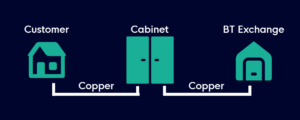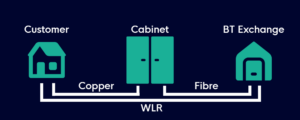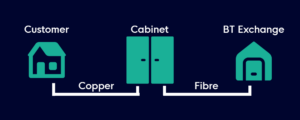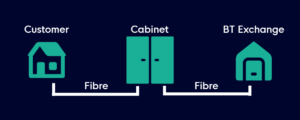Long gone are the days of fighting over a phone line to surf the web. With BT set to shut off the Public Switched Telephone Network (PSTN) by 2025, ISDN will cease to be serviced. Now there is a race to move the nation from aging copper networks to the future of fibre connectivity.
It won’t just be ISDN networks getting the axe, though. Premises connected using ADSL and Fibre to the Cabinet (FTTC) will also be in the crosshairs of BT and altnets alike. These connections utilise Wholesale Line Rental (WLR) which, after having been given the go ahead by Ofcom in 2006, was BT’s way of allowing telecommunications providers to use the PSTN.
While upgrading millions of connections to a more modern standard by 2025 might seem impossible, network providers are taking to the streets all over the UK to keep to the goal. There are new technologies coming in to play to offer faster and more reliable connections. This is all important in a world that has, especially in the past couple of years, become increasingly mobile and reliant on a higher standard of connectivity.
SOTAP
SOTAP stands for Single Order Transitional Access Product. This will be introduced in August 2022 in preparation for the 2023 “stop sell”, where providers will no longer be able to provision new WLR connections. WLR is the phone line part of the connection, so without WLR you’re purely providing internet access. SOTAP will still provide customers with a copper connection, which is useful for customers in areas that don’t have fibre yet but need a line without WLR. However, this is purely a temporary solution while the customer waits for Fibre to the Premises (FTTP) to be available in their area.
SOGEA
Single Order Generic Ethernet Access (SOGEA) performs in a similar way to FTTC in that the exchange delivers a fibre to the local cabinet or chamber, then completes the connection to the customer using a copper cable. The difference between the two is that a SOGEA connection removes WLR from the equation, disabling the possibility of using telephony services over the PSTN. Although this is a broadband connection, it still has a copper delivery, so the maximum speed attainable is 80Mbps, but you no longer need to order and pay for the separate phone connection.
SOGFAST
Single Order Gfast (SOGFAST) is a special version of SOGEA, where it has an extra pod on the side of the street cabinet or chamber that contains active equipment dedicated to boosting the speed. SOGFAST is capable of reaching up to 330Mbps on a broadband line, but this is dependent on the proximity of the cabinet to the premises.
FTTP
Fibre to the Premises (FTTP) is the end goal for the connectivity rollout this decade. With some providers offering up to 10Gbps, there will be little need to see connections faster than this in the near future. The connections’ active equipment will be located in the BT exchange, with only a light being passed through the optical fibres to a chamber. Due to the delicate nature of fibre optic cables these chambers tend to be sunk into the ground for higher security. Within a fibre optic cable you’ll find a core, containing numerous fibres capable of passing light. The light passing through these fibres can then be split, up to 64 times, though typically you want to split it no more than 32 times to maintain a high-grade service. This split light then passes through another fibre straight to the property. Splitting each fibre in a 24-core fibre optic cable 32 times means that one cable is capable of servicing up to 768 homes!





